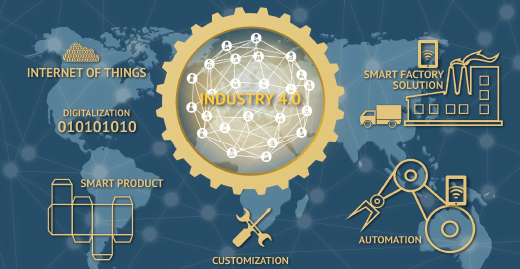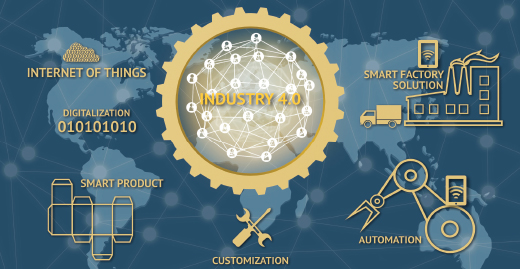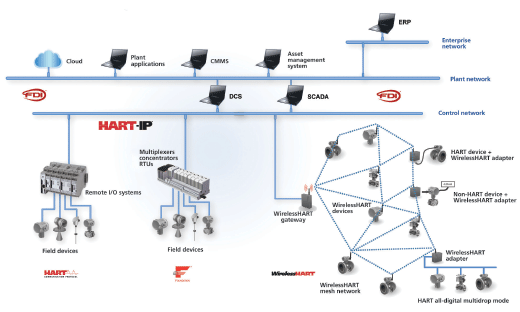- By Ted Masters
- InTech
Summary
Fast Forward
- Industrial digitalization, Industry 4.0, and the IIoT require integration with IT and OT systems.
- WirelessHART and HART-IP developments are paving the way to the benefits of intelligent devices with digital communications.
- The FieldComm Group and OPC Foundation are jointly developing OPC UA information models for process industries.

HART, FDI, and OPC UA collaboration simplifies applications
By Ted Masters

The IT and OT systems have traditionally been disconnected, preventing industrial organizations from sharing and leveraging key information to improve production, quality, and maintenance. Organizations can make significant manufacturing improvements by using sensor data to make intelligent decisions about plant assets and process automation systems with the assistance of enterprise and cloud tools. Common tasks, such as preventative maintenance and tracking information to predict when machinery needs repair before failure, shift unplanned maintenance to planned and lower the cost of operations. With the right data and information, personnel can anticipate problems and take appropriate corrective actions to keep the plant up and running.
IIoT and Industry 4.0 technology and methods are being adopted worldwide, redefining manufacturing. While the interoperability of IIoT-based devices and systems will no doubt be the subject of ongoing discussion over the next few years, there are already well-established standards in industrial and manufacturing environments that can accelerate the implementation of the digital plant.
User expectations
Proprietary solutions in industrial automation are quickly becoming a thing of the past. The engineers and end users of today-primarily driven by their experiences with consumer electronics-are no longer satisfied with products from different vendors not operating together seamlessly. This expectation now requires multivendor and multiplatform information integration from the sensor to the cloud. The days of the IT and OT worlds not communicating are also waning, with both sides seeking to convert data and metadata from plant assets into meaningful information. The joint activities of FieldComm Group and the OPC Foundation are bringing this reality into real-world focus.
Role of HART
The large installed base of HART and WirelessHART sensors and devices is a huge resource for real-time information that is already on processes and equipment. There are more than 30 million supported field instruments worldwide. HART technology is a reliable, long-term way to leverage the benefits of intelligent devices through digital communication to improve operations.
Simply communicating raw data from field devices to OT and IT systems is not a good solution. The noncontextual data does not have meaning to be productively used for higher-level applications, including predictive maintenance, analytics, and process optimization, unless duplicate contextual definition profiles are available in the receiving systems. This approach duplicates information, contributing to lower system reliability and brittle systems that have problems when configuration changes are made in databases and field devices. The FieldComm Group and OPC Foundation are cooperating to solve these issues.
OPC UA component
OPC UA is a platform-independent, service-oriented architecture that has standard models for secure and reliable information exchange in industrial automation. Developed by the OPC Foundation, it is an established standard for integration and interoperability between factory-level devices, supervisory and control systems, manufacturing execution systems, and enterprise applications, such as enterprise resource planning (ERP) and supply chain management. As a vendor-neutral international standard, OPC UA is also published as the IEC 62541 specification.
In 2016, the OPC Foundation delivered open-source OPC UA code to the software community, paving the way for greater interoperability. This eliminated the need for rigorous multivendor testing, which was once the norm in industrial automation.

FDI and OPC Foundation collaboration
The architects of FDI partnered with the OPC Foundation to include in the design of FDI the OPC UA technology that defines field devices and field device integration in the context of FDI technology. Specifically, the technologies share the same information model that defines the context of field devices in process automation. The goal is to ensure that as systems evolve, an open pathway to field device information is assured. To complete the architecture, the FieldComm Group, which is responsible for ongoing development of FDI technology, has collaborated with the OPC Foundation to provide a solution allowing data and metadata from intelligent device networks to be consumed by generic applications. More importantly, this data is converted into information that can be communicated into the IT world and leveraged directly by cloud-based applications. Integration with IT and OT systems is simplified, because the data communicated has the context of the data with all the information about the HART devices.
Standardization of devices, including their data and metadata, makes configuration easier, reduces application engineering labor, and simplifies training of new plant personnel, including operators, engineering, and maintenance. Training is a significant cost for any manufacturer, and having suppliers agree on data formats makes everyone's life easier.
FDI technology has been developed and supported by the automation industry's leading technology
foundations and suppliers. FDI is scalable and combines the advantages of FDT® with those of Electronic Device Description Language. FDI takes account of the various tasks over the entire life cycle for both simple and complex devices, including configuration, commissioning, diagnosis, and calibration.
OPC Foundation's president and executive director, Thomas J. Burke, emphasizes, "It has been rewarding to collaborate with FieldComm Group on crucial technology initiatives. Our organizations have a common strategy and vision. We understand the value of implementing the best specification and certification processes, and providing technology to our respective communities to bring world-class products to market."
I believe the FDI standard provides a proven solution for end users to better manage their assets by having standardized device configurations that are independent of the vendors and networking technologies involved with their respective installations. With FDI, the true potential of decentralization, transparency, integration, and a central view of all data and functions can be fully realized.
FDI device packages and EDDL
In automation systems with field instruments from a variety of vendors, there is a need to reduce the effort of installation, version management, and device operation. This requirement can only be met with an open and standardized device integration solution. For this reason, the FieldComm Group has specified a standard architecture for device integration FDI (IEC 61769) that applies IEC 61804, Electronic Device Description Language (EDDL), for the description of devices, including their representation in the OPC UA information model. Typical use cases for this solution include:
- interaction between users and the device (user interface)
- integration of new communication protocols (i.e., FDI communication servers)
- access to device information by OPC UA clients that are not FDI aware, such as archiving tools, maintenance tools, asset management, or ERP systems
FieldComm Group and the OPC Foundation cooperated on a companion specification defining how the information of a field device-described by an electronic device description document-is mapped to OPC UA objects, methods, and variables. The information model is primarily based on the OPC UA for Devices specification (IEC 61541-100); in fact, most of the OPC UA for Devices model has been driven by FDI requirements.
FieldComm Group's director of integration technology, Achim Laubenstein, states, "FDI technology manages information from intelligent field devices during their entire life cycle-from configuration, commissioning, and diagnostics to calibration, making one-off solutions for different devices obsolete. The standardization of field device information facilitates the development of native OPC UA applications that support the OPC UA device information model."
In addition to the device model, FDI defines how communication topologies of the automation system, representing the entire communication infrastructure, should be represented in an OPC UA AddressSpace. The comprehensive set of services provided by OPC UA enables the "how" of system integration.
Cloud applications
FieldComm Group's Integration Working Group is enhancing the FDI/OPC UA information model specification to provide semantics for machine-readable information. This specification will allow cloud-based applications to process field device information without extra configuration.
Mapping the FieldComm Group's data model to OPC UA enables frictionless OPC UA client/server and publisher/subscriber connections to the cloud. Applications that traditionally run on premise can now run globally in the cloud without having to change the interface to easily take advantage of robust cloud applications. Industrial organizations can have seamless information integration into cloud computing platforms, significantly enhancing compatibility and interoperability in the new digital world.
Future
FieldComm Group and the OPC Foundation are committed to developing complete infrastructures and solutions for seamless information integration in industrial automation applications. Both organizations recognize they must provide standards that help solve real-world problems and create new opportunities. This includes ongoing enhancements to the FDI standard, and potentially incorporating other organizations' networking technologies into a common integration architecture.
For more information, please visit the FDI Technology Overview (www.fieldcommgroup.org/technologies/fdi/fdi-technology).
Reader Feedback
We want to hear from you! Please send us your comments and questions about this topic to InTechmagazine@isa.org.


